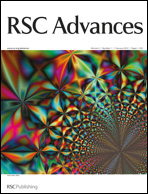Veruclay – a new type of photo-adsorbent active in the visible light range: modification of montmorillonite surface with organic surfactant
Abstract
Montmorillonite K10 was treated with VeruSOL-3, a biodegradable and food-grade surfactant mixture of coconut oil, castor oil and citrus extracts, to manufacture a benign catalytic adsorbent that is active in the visible light. Veruclay was characterized by SEM, XRD, TGA, UVDRS, and XPS analysis. The catalytic adsorption of cationic dye methylene blue (MB) and halogenated aromatic dichlorophenol (DCP) in the dark and visible light was assessed through the bench scale experiments. It was found that in the presence of visible light, MB degradation was nearly 100% in 45 min, whereas 75% of DCP was removed in 4 h. Demineralization of the solution in terms of TOC degradation of 18, 59, and 74% was achieved with 0.5, 1, and 2 g L−1 of Veruclay, respectively with DCP as a contaminant. Bacterial (Vibrio fischeri) bioluminescence inhibition assay demonstrated the effectiveness of Veruclay to significantly inhibit the microbial growth even at relatively low (50 mg L−1) Veruclay concentrations. It exhibited excellent stability for up to 7 consecutive runs and regained most of its catalytic activity after intermediate calcination.


 Please wait while we load your content...
Please wait while we load your content...